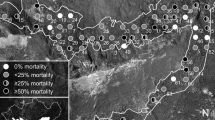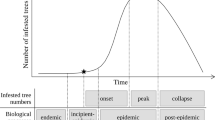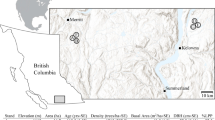Abstract
Climate conditions and forest structure interact to determine the extent and severity of bark beetle outbreaks, yet the relative importance of each may vary though the course of an outbreak. In 2008, we conducted field surveys and reconstructed forest conditions at multiple stages within a recent mountain pine beetle (MPB) outbreak in Rocky Mountain National Park, Colorado. At each stage in the outbreak, we examined changes in (1) lodgepole pine mortality and surviving stand structure, (2) the influence of topographic versus stand structure variables on mortality rates, and (3) stand complexity and landscape heterogeneity. Lodgepole pine mortality reduced basal area by 71 %, but only 47 % of stems were killed. Relative to pre-outbreak stands, surviving stands had lower mean dbh (11.0 vs. 17.4 cm), lower basal area (8.5 vs. 29.3 m2 ha−1), lower density (915 vs. 1,393 stems ha−1), and higher proportions of non-host species (23.1 vs. 10.6 % m2 ha−1). Factors predicting mortality rates changed through the course of the outbreak. Tree mortality during the early stage of the outbreak was associated with warm, dry sites and abundant large trees. During the middle and late stages, mortality was associated with stand structure alone. Stand complexity increased, as defined by stand-scale variability in density, basal area, and the proportion of susceptible trees. Landscape heterogeneity decreased according to semi-variograms of tree diameter and basal area. Increased stand complexity may inhibit future MPB population development, but decreased landscape heterogeneity may facilitate outbreak spread across the landscape if a future outbreak were to irrupt.



Similar content being viewed by others
References
Adams HD, Guardiola-Claramonte M, Barron-Gafford GA, Villegas JC, Breshears DD, Zoug CB, Troch PA, Huxman TE (2009) Temperature sensitivity of drought-induced tree mortality portends increased regional die-off under global-change-type drought. P Natl Acad Sci USA 106(17):7063–7066
Ager AA, McMahan A, Hayes JL, Smith EL (2007) Modeling the effects of thinning on bark beetle impacts and wildfire potential in the Blue Mountains of eastern Oregon. Landscape Urban Plan 80(3):301–311
Amman GD, Cole WE (1983) Population dynamics. In: Mountain pine beetle dynamics in lodgepole pine forests Part 2. USDA Forest Service GTR INT-145, pp 1–59
Aoki CF (2010) Fire history and serotiny in the Rocky Mountains of Colorado. Thesis, Colorado State University
Aukema BH, Carroll AL, Zhu J, Raffa KF, Sickley TA, Taylor SW (2006) Landscape level analysis of mountain pine beetle in British Columbia, Canada: spatiotemporal development and spatial synchrony within the present outbreak. Ecography 29(3):427–441
Aukema BH, Carroll AL, Zheng Y, Zhu J, Raffa KF, Moore RD, Stahl K, Taylor SW (2008) Movement of outbreak populations of mountain pine beetle: influences of spatiotemporal patterns and climate. Ecography 31(3):348–358
Beers TW, Dress PE, Wensel LC (1966) Aspect transformation in site productivity research. J Forest 64(10):691–692
Bentz B (ed) (2005) Bark beetle outbreaks in western North America: causes and consequences. University of Utah Press, Snowbird, p 42
Bentz BJ, Regniere J, Fettig CJ, Hansen EM, Hayes JL, Hicke JA, Kelsey RG, Negrón JF, Seybold SJ (2010) Climate change and bark beetles of the western United States and Canada: direct and indirect effects. Bioscience 60(8):602–613
Beven KJ, Kirkby MJ (1979) A physically based, variable contributing area model of basin hydrology. Hydrol Sci Bull 24(1):43–69
Bigler C, Gavin DG, Gunning C, Veblen TT (2007) Drought induces lagged tree mortality in a subalpine forest in the Rocky Mountains. Oikos 116(12):1983–1994
Blate GM, Joyce LA, Littell JS, McNulty SG, Millar CI, Moser SC, Neilson RP, O’Halloran K, Peterson DL (2009) Adapting to climate change in United States national forests. Unasylva 60:57–62
Breshears DD, Cobb NS, Rich PM, Price KP, Allen CD, Balice RG, Romme WH, Kastens JH, Floyd ML, Belnap J, Anderson JJ, Myers OB, Meyer CW (2005) Regional vegetation die-off in response to global-change-type drought. P Natl Acad Sci USA 102(42):15144–15148
Chapman TB, Veblen TT, Schoennagel T (2012) Spaciotemporal patterns of mountain pine beetle activity in the southern Rocky Mountains. Ecology 93(10):2175–2185
Cole WE, Amman GD (1980) Course of an infestation. In: Mountain pine beetle dynamics in lodgepole pine forests, Part 1. USDA Forest Service GTR INT-89:1–56
Collins BJ, Rhoades CC, Underhill J, Hubbard RM (2010) Post-harvest seedling recruitment following mountain pine beetle infestation of Colorado lodgepole pine stands: a comparison using historic survey records. Can J Forest Res 40(12):2452–2456
Collins BJ, Rhoades CC, Hubbard RM, Battaglia MA (2011) Tree regeneration and future stand development after bark beetle infestation and harvesting in Colorado lodgepole pine stands. Forest Ecol Manag 261(11):2168–2175
Craig RK (2010) ‘Stationarity is dead’ - long live transformation: five principles for climate change adaptation law. Harvard Environ Law Rev 34(1):9–75
Dale VH, Joyce LA, McNulty S, Neilson RP, Ayers MP, Flannigan MD, Hanson PJ, Irland LC, Lugo AE, Peterson CJ, Simberloff D, Swanson FJ, Stocks BJ, Wotton BM (2001) Climate change and forest disturbances. Bioscience 51(9):723–734
de la Giroday HMC, Carroll AL, Lingren BS, Aukema BH (2011) Incoming! Association of landscape features with dispersing mountain pine beetle populations during a range expansion event in western Canada. Landscape Ecol 26:1097–1110
Diskin M, Rocca ME, Nelson KN, Aoki CF, Romme WH (2011) Forest developmental trajectories in mountain pine beetle disturbed forests of Rocky Mountain National Park, Colorado. Can J Forest Res 41:782–792
ESRI (2006) ArcGIS Desktop: Release 9.2. Redlands, CA: Environmental Systems Research Institute
Fettig CJ, Klepzig KD, Billings RF, Munson AS, Nebeker TE, Negrón JF, Nowak JT (2007) The effectiveness of vegetation management practices for prevention and control of bark beetle infestations in coniferous forests of the western and southern United States. Forest Ecol Manag 238(1–3):24–53
Kayes LJ, Tinker DB (2012) Forest structure and regeneration following a mountain pine beetle epidemic in southeastern Wyoming. Forest Ecol Manag 263:57–66
Keen FP (1955) The rate of natural falling of beetle-killed ponderosa pine snags. J Forest 53:720–723
Klutsch JG, Negron JF, Costello SL, Rhoades CC, West DR, Popp J, Caissie R (2009) Stand characteristics and downed woody debris accumulations associated with a mountain pine beetle (Dendroctonus ponderosae Hopkins) outbreak in Colorado. Forest Ecol Manag 258(5):641–649
Kramer M (2005) R2 statistics for mixed models. In: Boyer JE (ed) 17th Annual Kansas State University Conference on Applied Statistics in Agriculture, Manhattan, KS, pp 148–160
Leatherman DA (2008) The health of Colorado’s forests: high elevation forests. Colorado Department of Natural Resources and Colorado State Forest Service, Fort Collins, p 17
Legendre P, Fortin MJ (1989) Spatial pattern and ecological analysis. Vegetatio 80(2):107–138
Li H, Reynolds JF (1995) On definition and quantification of heterogeneity. Oikos 73(2):280–284
Liebhold AM, Tobin PC (2008) Population ecology of insect invasions and their management. Annu Rev Entomol 53:387–408
Logan JA, Regniere J, Powell JA (2003) Assessing the impacts of global warming on forest pest dynamics. Front Ecol Environ 1(3):130–137
Magee L (1990) R2 measures based on wald and likelihood ratio joint significance tests. Am Stat 44(3):250–253
Mitchell RG, Waring RH, Pitman GB (1983) Thinning lodgepole pine increases tree vigor and resistance to mountain pine-beetle. Forest Sci 29(1):204–211
Negron JF, McMillin JD, Anhold JA, Coulson D (2009) Bark beetle-caused mortality in a drought-affected ponderosa pine landscape in Arizona, USA. Forest Ecol Manag 257(4):1353–1362
Nelson KN (2009) The effect of mountain pine beetle caused mortality on subalpine forest stand and landscape structure in Rocky Mountain National Park, CO. Thesis, Colorado State University
Nigh GD, Antos JA, Parish R (2008) Density and distribution of advance regeneration in mountain pine beetle killed lodgepole pine stands of the montane spruce zone of southern British Columbia. Can J Forest Res 38(11):2826–2836
NRCS (2007) Soil survey of Rocky Mountain National Park, Colorado. United States Department of Agriculture, Natural Resources Conservation Service. Available from http://websoilsurvey.nrcs.usda.gov/app. Accessed August 2009)
Oliver T, Roy DB, Hill JK, Brereton T, Thomas CD (2010) Heterogeneous landscapes promote population stability. Ecol Lett 13(4):473–484
Peet RK (2000) Forests and meadows of the Rocky Mountains. In: Barbour MG, Billings WD (eds) North American terrestrial vegetation. Cambridge University Press, New York, pp 75–122
Peters DPC, Pielke RA, Bestelmeyer BT, Allen CD, Munson-McGee S, Havstad KM (2004) Cross-scale interactions, nonlinearities, and forecasting catastrophic events. P Natl Acad Sci USA 101(42):15130–15135
Pielke AE Sr, Doesken N, Bliss O, Green T, Chaffin C, Salas JD, Woodhouse CA, Lukas JJ, Wolter K (2005) Drought in Colorado: an unprecedented drought or a routine drought? Pure Appl Geophys 162:1455–1479
Pinheiro J, Bates D, DebRoy S, Sarkar D, team tRC (2009) nlme: linear and nonlinear mixed effects models. R package version 3.1-92
R Development Core Team (2009) R: a language and environment for statistical computing. In: R foundation for statistical computing, 2.9.1 edn., Vienna, Austria
Raffa KF, Aukema BH, Bentz BJ, Carroll AL, Hicke JA, Turner MG, Romme WH (2008) Cross-scale drivers of natural disturbances prone to anthropogenic amplification: the dynamics of bark beetle eruptions. Bioscience 58(6):501–517
Regniere J, Bentz B (2007) Modeling cold tolerance in the mountain pine beetle, Dendroctonus ponderosae. J Insect Physiol 53(6):559–572
Reich R (2008) RSpatial: spatial statistical modelling of ecosytem resources and the environment. Colorado State University, Fort Collins
Rocca ME, Romme WH (2009) Beetle-infested forests are not “destroyed”. Front Ecol Environ 7(2):71–72
Safranyik L, Carroll AL (2006) The biology and epidemiology of mountain pine beetle in lodgepole pine forests. In: Safranyik L, Wilson B (eds) The mountain pine beetle: a synthesis of its biology, management and impacts on lodgepole pine. Canadian Forest Service: Pacific Forestry Center, Natural Resources Canada, Victoria, pp 3–66
Schowalter TD (2006) Insect ecology: an ecosystem approach. Academic Press, Burlington
Schowalter TD, Turchin P (1993) Southern pine beetle infestation development: interaction betwen pine and hardwood basal areas. Forest Sci 39:201–210
Seastedt TR, Hobbs RJ, Suding KN (2008) Management of novel ecosystems: are novel approaches required? Front Ecol Environ 6(10):547–553
Shore TL, Safranyik L, Lemieux JP (2000) Susceptibility of lodgepole pine stands to the mountain pine beetle: testing of a rating system. Can J Forest Res 30(1):44–49
Shore TL, Safranyik L, Hawkes BC, Taylor AH (2007) Effects of the mountain pine beetle on lodgepole pine stand structure and dynamics. In: Safranyik L, Wilson B (eds) The mountain pine beetle: a synthesis of biology, management, and impacts in lodgepole pine. Canadian Forest Service: Pacific Forestry Center, Natural Resources Canada, Victoria, p 299
Sibold JS, Veblen TT, Gonzalez ME (2006) Spatial and temporal variation in historic fire regimes in subalpine forests across the Colorado Front Range in Rocky Mountain National Park, Colorado. USA. J Biogeogr 33(4):631–647
Sibold JS, Veblen TT, Chipko K, Lawson L, Mathis E, Scott J (2007) Influences of secondary disturbances on lodgepole pine stand development in rocky mountain national park. Ecol Appl 17(6):1638–1655
Stokes MA, Smiley TL (1968) An introduction to tree-ring dating. University of Chicago Press, Chicago
Teste FP, Lieffers VJ, Landhausser SM (2011) Seed release in serotinous lodgepole pine forests after mountain pine beetle outbreak. Ecol Appl 21(1):150–162
Theobald DM, Stevens DL, White D, Urquhart NS, Olsen AR, Norman JB (2007) Using GIS to generate spatially balanced random survey designs for natural resource applications. Environ Manag 40(1):134–146
US Forest Service (2013) USDA Forest Service, Rocky Mountain Region—Aerial Survey Data Download. Available at http://www.fs.usda.gov/detail/r2/forest-grasslandhealth/?cid=fsbdev3_041629. Accessed August 2013
van Mantgem PJ, Stephenson NL, Byrne JC, Daniels LD, Franklin JF, Fule PZ, Harmon ME, Larson AJ, Smith JM, Taylor AH, Veblen TT (2009) Widespread increase of tree mortality rates in the western United States. Science 323(5913):521–524
Vyse A, Ferguson C, Huggard DJ, Roach J, Zimonick B (2009) Regeneration beneath lodgepole pine dominated stands attacked or threatened by the mountain pine beetle in the south central interior, British Columbia. Forest Ecol Manag 258:S36–S43
Westerling AL, Turner MG, Smithwick EAH, Romme WH, Ryan MG (2011) Continued warming could transform Greater Yellowstone fire regimes by mid-21st century. P Natl Acad Sci USA 108(32):13165–13170
Westerling AL, Hidalgo HG, Cayan DR, Swetnam TW (2006) Warming and earlier spring increase western US forest wildfire activity. Science 313(5789):940–943
Acknowledgments
We are grateful to Dan Binkley, Monique Nelson, and Daniel Tinker for providing invaluable help reviewing this manuscript. Thank you to Brandon Corcoran, Jared Lyons, and Greg Pappas for a flawless summer of fieldwork. We acknowledge Phil Chapman for his advice regarding statistical analyses. We also thank Nathan Williamson, Jeff Connor, and Judy Visty for their knowledge and support at Rocky Mountain National Park. This project was funded by the National Park Service and McIntire-Stennis appropriations to Colorado State University.
Author information
Authors and Affiliations
Corresponding author
Rights and permissions
About this article
Cite this article
Nelson, K.N., Rocca, M.E., Diskin, M. et al. Predictors of bark beetle activity and scale-dependent spatial heterogeneity change during the course of an outbreak in a subalpine forest. Landscape Ecol 29, 97–109 (2014). https://doi.org/10.1007/s10980-013-9954-1
Received:
Accepted:
Published:
Issue Date:
DOI: https://doi.org/10.1007/s10980-013-9954-1




